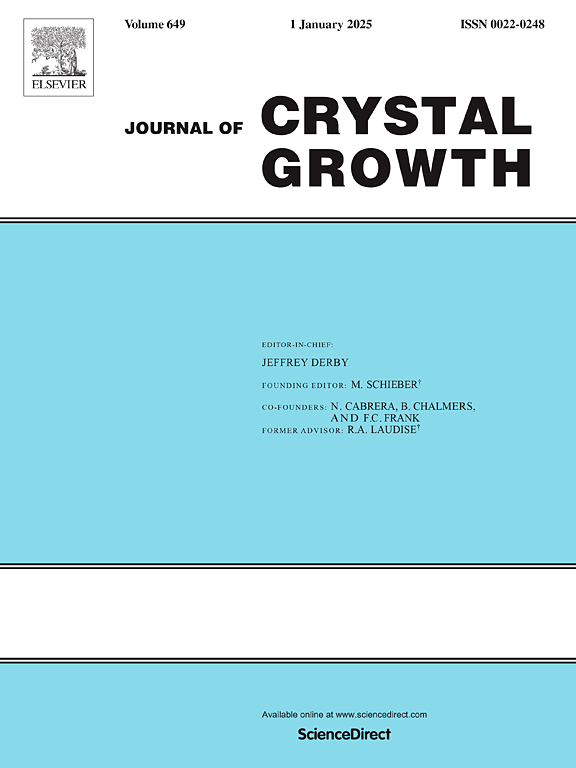用再溶解法在Te溶液中生长无空洞的znte基晶体
IF 1.7
4区 材料科学
Q3 CRYSTALLOGRAPHY
引用次数: 0
摘要
孔洞缺陷在锌钛基晶体中普遍存在,并对其性能产生不利影响。本研究旨在阐明孔隙的组成和形成机制。本实验采用Te溶液法生长ZnTe晶体。能谱分析(EDS)结果表明,C、Te和Zn元素分布在孔洞表面。x射线光电子能谱(XPS)结果表明,C元素主要以零价存在。这些结果表明,石英坩埚表面的碳膜一定参与了气泡的形成。碳膜可能与Te溶液反应产生一种CTen气体,然后溶解在Te溶液中。当温度降低时,气体的溶解度降低,导致气泡在固液界面或溶液内成核,并进一步长大。当气泡被固液界面包裹时,就会在晶体中形成空洞。为了消除znte基晶体中的空洞,在晶体生长过程中,开发了低-高温循环程序,在界面附近重新溶解晶体并释放空洞。傅里叶变换红外光谱(FTIR)表明,再溶解法制备的znte基晶体的光学性能得到了显著改善。本文章由计算机程序翻译,如有差异,请以英文原文为准。
The growth of void-free ZnTe-based crystals from Te solution by re-dissolution procedure
Void defects are prevalent in ZnTe-based crystals and detrimentally impact their properties. This research aims to elucidate the composition and formation mechanism of the voids. In this experiment, ZnTe crystals were grown by the Te solution method. Energy dispersive spectroscopy (EDS) results demonstrate that the C, Te and Zn elements are distributed on the void surfaces. X-ray photoelectron spectroscopy (XPS) results indicate that the C element mainly exists as zero valence. These results suggest that the carbon film coated on the surface of the quartz crucible must be implicated in the bubble formation. Carbon film possibly reacts with the Te solution to produce a kind of CTen gas, which then dissolves into the Te solution. When the temperature decreases, the solubility of the gases diminishes, leading to the bubbles nucleate at the solid–liquid interface or within the Te solution, and further grow. When a bubble is wrapped by the solid–liquid interface, it evolves into a void in the crystal. To eliminate void in ZnTe-based crystals, the low–high temperature cycle procedure was developed to re-dissolve the crystals near the interface and released void, during the crystal growth. Fourier transform infrared spectrometer (FTIR) spectrum demonstrates that the optical properties of the ZnTe-based crystals grown by the re-dissolution procedure are improved significantly.
求助全文
通过发布文献求助,成功后即可免费获取论文全文。
去求助
来源期刊

Journal of Crystal Growth
化学-晶体学
CiteScore
3.60
自引率
11.10%
发文量
373
审稿时长
65 days
期刊介绍:
The journal offers a common reference and publication source for workers engaged in research on the experimental and theoretical aspects of crystal growth and its applications, e.g. in devices. Experimental and theoretical contributions are published in the following fields: theory of nucleation and growth, molecular kinetics and transport phenomena, crystallization in viscous media such as polymers and glasses; crystal growth of metals, minerals, semiconductors, superconductors, magnetics, inorganic, organic and biological substances in bulk or as thin films; molecular beam epitaxy, chemical vapor deposition, growth of III-V and II-VI and other semiconductors; characterization of single crystals by physical and chemical methods; apparatus, instrumentation and techniques for crystal growth, and purification methods; multilayer heterostructures and their characterisation with an emphasis on crystal growth and epitaxial aspects of electronic materials. A special feature of the journal is the periodic inclusion of proceedings of symposia and conferences on relevant aspects of crystal growth.
 求助内容:
求助内容: 应助结果提醒方式:
应助结果提醒方式:


